


Dislocate 07
Ginza and Koiwa, Tokyo - 24th July - 5th August
|
‘Ere Be Dragons Project Description: ‘Ere Be Dragons plays games with your heart. ’Ere be Dragons playfully recasts players’ relationship both with the space they inhabit and with the unseen space within their bodies. The player’s own body becomes an engaging new companion, a soft machine whose physical response to their exertions they can sense and understand as they walk along. To play you will need to book in for a 20 minute walk exploring the surrounding city streets. ‘Ere Be Dragons is a metaphor based on the maps created in the West in the Middle Ages. Explorations of the unknown areas of the earth were often illustrated as being populated with dragons, forests and wild beasts. Mapmakers were reliant on anecdotal information from explorers keen to impress with tales of bravery and as consequence the information was embellished with fantasy and hearsay. Partners and Funders: 'Ere Be Dragons has been developed by Active Ingredient in collaboration with Robin Shackford, Lansdown Centre for Electronic Arts, London Sport Institute at Middlesex University, Hewlett Packard Mobile Bristol, and the Mixed Reality Lab, Nottingham University 'Ere Be Dragons has been funded by a Sci-Art Research and Development Grant from the Wellcome Trust and a commission from the Radiator Festival for New Technology Art 2006. Artist’s Statement: Active Ingredient’s motivation in the development of ‘Ere Be Dragons was to create an experience that used the tools of game play to build a visualisation of the player’s internal and external worlds. The aim was to generate levels of conceptual and mythological meaning from the feedback of the player’s heart rate as they walked through a real physical landscape, therefore creating a map of the player's personal interaction with their environment. Active Ingredient is in the process of exploring computer games from an artistic perspective. The aim within the ‘Ere Be Dragons project was to create an experience through game play that went beyond the traditional definition of a game or artwork. The project’s conceptual thread lay in the artist’s ideas about creative mapping. By using heart rate as a means to map real space we were interested in the representation of an emotional city, seen less as streets and buildings but more as a visualisation of the internal processes of the players. ‘Ere Be Dragons became a project where we could explore ways of altering the experience of the real world through game play, virtual space and remote space, themes that have been recurrent in our work since 1996. The liveness and the live feedback (through the heart rate of the players) are therefore central to this experience of interaction. |
|
_____________________________________________________________________________________________________
|
Bio Mapping is a community mapping project in which over the last three years almost 1000 people have taken part in. In the context of regular, local workshops, participants are wired up with an innovative device which records the wearer's Galvanic Skin Response (GSR), which is a simple indicator of the emotional arousal in conjunction with their geographical location. People re-explore their local area by walking the neighbourhood with the device and on their return a map is created which visualises points of high and low arousal. By interpreting and annotating this data, communal emotion maps are constructed that are packed full of personal observations which show the areas that people feel strongly about and truly visualise the social space of a community.
|
 |
_____________________________________________________________________________________________________
|
the daily practice of map making If at the end of your life, you could look at the shapes your wanderings over the earth have made, what patterns would you see? What words might be formed that take a human lifetime to write? Dan's work crosses a number of disciplines: performance, psychogeography, locative media, video and fine art. Since April 2003 he has recorded every journey he has made with a GPS. Dan is fascinated by the idea that locations (interior or exterior) serve as a mnemonic for the stories that we tell about our lives and often work to reveal these human narratives (my own and other peoples') bound to a place.
http://www.planbperformance.net/dan/
|
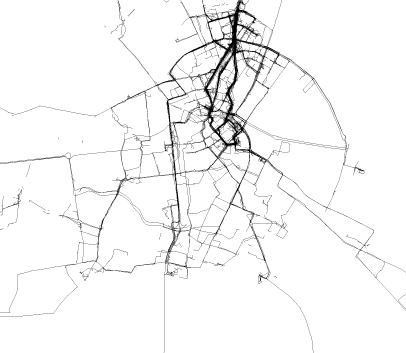 |
_____________________________________________________________________________________________________
|
Undercurrent
|
 |
____________________________________________________________________________________________________
|
A recent work ‘Shoot me if you can’ utilized mobile phones for a city wide muli-player game, in which teams compete against each other to be the first to photograph their opponents and the last to be captured themselves. http://tyshow.org |

____________________________________________________________________________________________________
 |
|
|
DoMistic: Technology and
Economic Erik investigates the impact of technology on his hometown of Bandung, Indonesia, and through new media comments upon the city’s social, cultural and daily life. |
____________________________________________________________________________________________________
|
Curator of Urban Vibe at NABI Art Center, Seoul, So-Hyeon has been working with artists, scientists and technicians to explore the city through mobile and locative media. |
 |
____________________________________________________________________________________________________
| http://www.h6.dion.ne.jp/~moo/ | 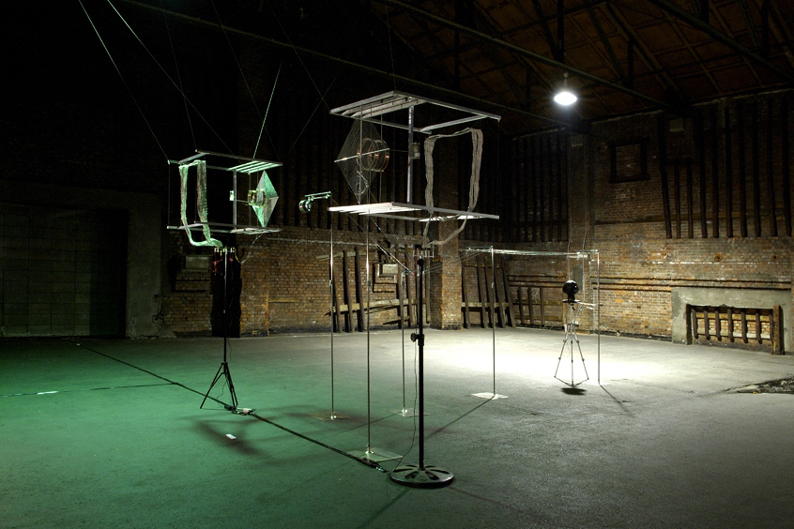 |
____________________________________________________________________________________________________
|
Sensity by Stanza Visualizing the dynamic data around my district as an audio visual artwork. I have set up a wireless sensor network around my house in London. I live nearby a railway line, a factory, some trees and a mobile phone mast. (This is using real data). This is version three of this project. The city is made up of bits of data that change. This artwork captures this change to try to understand the underlying fabric of city space. Sensity is part of "The Emergent City" series of works by Stanza. Collecting data across the city of London which visualized to make art. The whole world is a dynamic real time artwork. The city data space becomes mirrored online and the environment becomes an emergent series generative artworks Sensity artworks are made from the data that is collected across the urban and environment infrastructure. A network of sensors, some fixed, and some embedded, collects data which is then published online. The sensors then interpret the micro-data of the interactive city. The output from the sensors displays the emotional state of the city online and the information will be used to create installations and sculptural artifacts. These artworks made will represent the movement of people, pollution in the air, the vibrations and sounds of buildings, they are in effect emergent social sculptures visualizing the emotional state of the city. The sensor network can be moved from urban to rural setting and different types of visualization can be made depending on the environment. Sensity is an open social sculpture that informs the world and creates new meaningful experiences. http://www.stanza.co.uk/sensity/index.html
|
 |
____________________________________________________________________________________________________
|
"Blackout" by Disinformation features
video footage of concrete parabolic air-defence Sound Mirrors, built at
various sites on the UK coast between WW1 and WW2. The purpose of the
Sound Mirrors was to function as an early warning system - a primitive
acoustic equivalent of Radar, to enable listeners to locate the sounds
of attacking aircraft and ships. "Blackout" was filmed by Barry Hale (of
Threshold Studios and Warp X), and was conceived as an installation
supplement to the Sound Mirror images by photographer Julian Hills
published in 1997 on the sleeve of the Disinformation "Antiphony" double
CD. The production of "Blackout" took place towards the end of a century
in which technological innovation and the brutalities of war went hand
in hand. Like immersion in darkness, experiences of danger place
individuals in heightened states of physiological awareness, increasing
sensitivity of the nervous system to a broad range of environmental
cues. Allied to the evolution of military R&D, this fact of animal
psychology assumes concrete material forms - anxiety manifests as early
warning systems - which dramatically extend perceptions in terms of
distance, subtlety and bandwidth. With the onset of tactical
obsolescence these systems are abandoned or dismantled, leaving a
remarkable architectural legacy. "Blackout" is designed to suggest and
explore relationships between military archaeology, sensory acuity,
archaeology and vernacular avant-garde architecture. Blackout explores
the philosopher Friedrich Schelling's concept of "architecture as frozen
music". Disinformation is a highly experimental electronic music and sound art project, which, since 1995, pioneered the use of electromagnetic (radio) noise from the sun, lightning and electric storms, live mains electricity, laboratory equipment, industrial, metro, railway and IT hardware and geomagnetic storms etc as the raw material of CDs, LPs, DJ sets, concerts and sound installations. Since this time, Disinformation has also evolved into a widely exhibited kinetic, video and visual arts project. Sci-Fi author Jeff Noon wrote in The Independent that "people are fascinated by this work", and The Guardian commented "Disinformation combine scientific nous with poetic lyricism to create some of the most beautiful installations around". Disinformation artworks have been the subject of 9 UK solo exhibitions. The name "Disinformation" is used in the spirit of what Wittgenstein referred to as "The Liar's Paradox", however "Rorschach Audio" a research project conducted by Disinformation's main author has been peer-reviewed by leading academics and published by (amongst others) The MIT Press. http://en.wikipedia.org/wiki/Disinformation_%28art_and_music_project%29
|
 |
____________________________________________________________________________________________________
|
“At the seashore,
between the land of atoms and the sea of bits, we are now facing the
challenge of reconciling our dual citizenship in the physical and
digital worlds.” Hiroshi Ishii, MIT Media Lab |
 |
||
____________________________________________________________________________________________________
Life Speculatrix"Life Speculatrix" is an evolutionary physical skin based on feedback retrieved locally and globally. Locally it responds to sound, light and proximity of people around it. Globally it responds to RSS/Atom environmental feeds retrieved through the webspace: pollution levels, climate features, sound, from around the world will affect its performance continually. With this experiment we argue that a human computer interface framework has to include the phenomenological environmental matrix and the complexity of human input in order to create a truly living interactive experience and not just a detached interactive art device. We will observe the “evolution” of this piece according to different stimuli, give it our feedback and observe how it learns to adapt itself continually to the evolutionary properties of the environment, thus becoming a universal situated living piece. All the necessary and sufficient conditions are therefore present for a “hidden dimension” to be added to a global/local phenomenology and a poetics of visual space.
|
 |
____________________________________________________________________________________________________
|
Buttons
Taking a photo means making a memory.
Choosing a moment in time and framing a situation. Archiving it or
making it public. Either way, we create a visual item that we have an
emotional attachment to through our memory. Photos help us to remember
moments in our past. Often they even become a memory in their own right.
For many, making their moments public through services like
Flickr is already part the process
of photography itself, creating archives which contain a vast collection
of visual fragments of individual lives. After a few minutes or hours, depending on how soon someone else shares their photo on the web, an image will appear on the screen. In a way, it belongs half to the person who had pressed the button and still remembers that moment. Because of that connection, the photos are never dismissed as random, no matter how enigmatic they may be. |
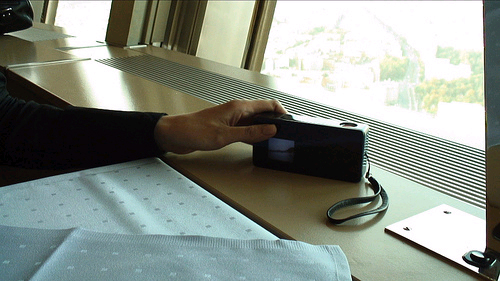  |
____________________________________________________________________________________________________
Andreas Schlegel and Vladimir Todorovic
|
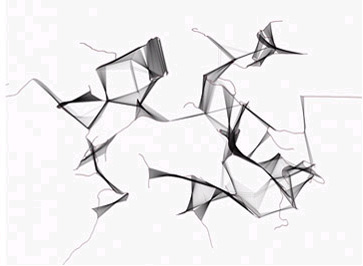  |
____________________________________________________________________________________________________
Miguel Andrés-Clavera and Inyong Cho
|
scanMemories scanMemories is an interdisciplinary art project that uses RFID (Radio Frequency Identification), databases and mobile and wireless technologies and. It opens a heterogeneous and direct access to the memories materialized in physical spaces and objects. The project examines how memory practices in death can be altered by information technologies. This includes the questions about how information can alter embodied relation with the materiality of memory objects and space, and how this can change the issues of identity and privacy about the dead. The main characteristics of the scanMemories system are: n The database is populated with media contents by those who want to share their lives after their death, or the bereaved who wish to cherish the memory using an online tool created for the project. n RFID tags are implanted in memory objects (such as tombstones or clothing) which serve as gates to access the memory database. n The information can only be accessed in the exact location where the RFID tag has been placed as the deceased wished, and it is retrieved by the people who the deceased wanted to share with. The people use wireless and mobile devices customized for the application. With our project, we explore how information technologies can alter our perception about the post-identity of the deceased and also our sensory relation with memory objects, and how they can produce complex meaning about the death and remembrance in a highly networked society.
scanMemories
is funded by FACT (Foundation for Art and Creative Technology) and
supported by Arts Council England.
|
 |
____________________________________________________________________________________________________
Mouna Andraos & Sonali Sridhar
AddressAddress is a handmade jewellery piece designed and created by Mouna Andraos and Sonali Sridhar. When you first acquire the pendant, you select a place that you consider to be your anchor – where you were born, your home, or perhaps the place you long to be. Once the jewellery is initialized, every time you wear the piece it displays how many miles away from that location you are using a GPS component built into the pendant. As you take Address around the world with you, it serves as a personal connection to that special place, making the world a little smaller or maybe a little bigger. |
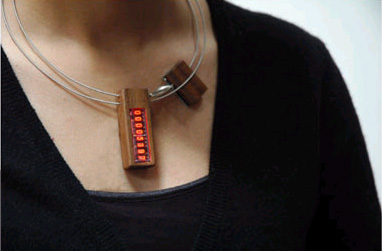 |
___________________________________________________________________________________________________
|
white paper-s Video and sound installation with several performance by "white paper"
|
 |
____________________________________________________________________________________________________
|
Des lendemains radieux (Beautiful promises) is an attempt to reconsider our environment through the prismes of prospective and poetry, by awakening the attention about the extraordinary interactions between the man and the nature, from the history of the world until the sudden appearance of modernity. "Culture... is what made the human kind something else that an accident of the universe" André Malraux.
|
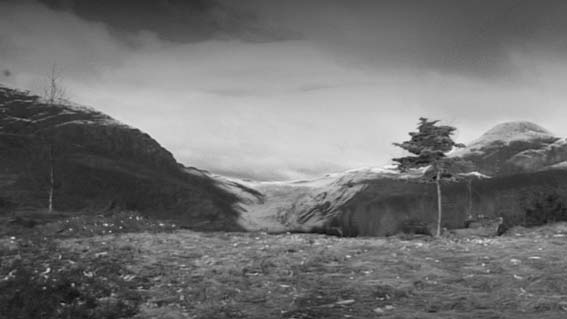
|
____________________________________________________________________________________________________
|
Sakura, 2007 Digital video, colour, sound, 6:48 Sound: Jonathan Perl Sakura focuses on hanami in Tokyo, revealing people’s individual responses to the blossom. Collated from a week’s filming but edited to present a single day’s experience from morning until night, Sakura is a meditation on the integration of man-made technologies into the appreciation of a natural phenomenon already manipulated by human intervention. As a subjective digital edit of the blossom viewers’ ad hoc camera phone digital editing in action, veering between recording this behaviour and participating in it, Sakura creates a second subjective and initially transparent layer of remove between the viewer and the reality of the blossom.
|

|
____________________________________________________________________________________________________
|
We all fade away (2007) begins with a slow zoom into a still image of tourists, all gazing at something we cannot see (the photograph was taken at the Niagra Falls). Over time each spectator is blacked out as they are transformed into birds that slowly fly off into the distance. The animations are accompanied by an atmospheric soundtrack of beats and synths. The work is about death and loss – the rise and fall of human endeavor – but it isn't melancholic. Articulating an apprehension of our fragility and promoting a longer view, it unties by playing on our shared humanity and inspires a philosophic feeling of the 'bigger picture', a cyclical view of life from an alternative perspective. www.nishaduggal.co.uk |
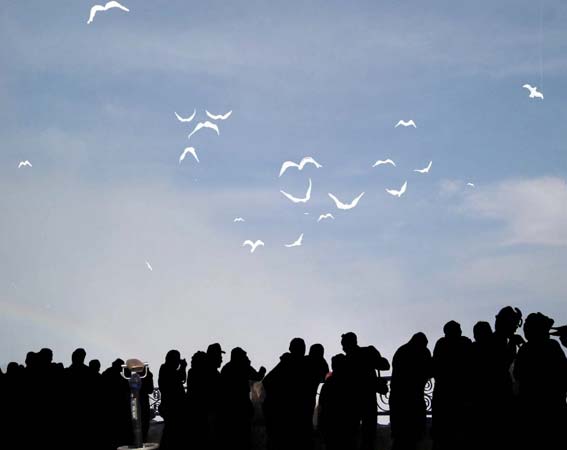
|
____________________________________________________________________________________________________
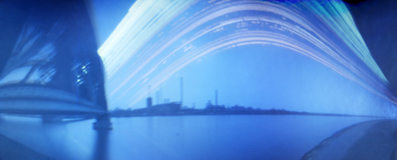 |
|
|
Solarigrafica shows
the paths of the Sun by using the Pinhole camera technique. This
photographs are taken with exposure times from 1 day till 6 months. By
doing so the invisible movements of the Sun can be made visible in
landscapes. A Soundscape of recorded and with a granular synthesis
processed samples creates a spherical, alienated atmosphere.
|
____________________________________________________________________________________________________
|
J9 - Computational Video J9 is a video installation that explores the relationship between journey and narrative; it uses sound and image to draw the audience into the rhythmic cycles of travel. Working with a 9 minute editing structure generated from both audio and visual pacing, multiple versions of a sequence are created using a video database of a diverse range of physical locations. The installation makes reference to the use of “computational video” as it incorporates software systems to sequence the audio and visual video edits. The use of a recurring form is intended to evoke the way in which we map our own internal experience onto diverse locations and cultures as we travel. The soundtrack is composed from location audio samples and musical elements,allowing the audiovisual rhythm to evoke an emotional sense of transitions through different physical environments. The piece loops on multiple screens in the gallery space and as we follow the same narrative, each of the 9 iterations takes us on a different audio-visual journey julian konczak J9
|
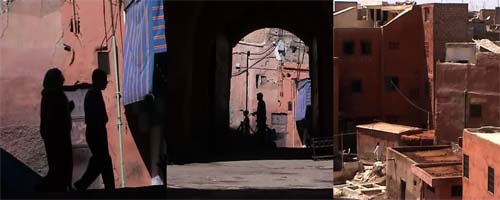
|
____________________________________________________________________________________________________
|
Time_Space_Frames_Ginza will
align various architectural spaces that been photographed around the
Ginza Art Laboratory site, with the shutter of a camera. The windows and
doors of buildings will systematically shut in response to pressing the
shutter button of an old SLR camera. Through old and new photographic
technology, the relationship between the photographer's perception and
actions, the immediate surrounding environment and the time-space
continuum is interrogated.
|
 |
____________________________________________________________________________________________________
|
ReadyMadeLife Video made exclusively with images filmed by video-surveillance camera monitors. This images are taken in the city I live, Genova (Italy) and in Zurich (Swiss). The central meaning is the predetermination of the experience implicit in all our life. I think that our behavior depends on the cultural and the linguistic system that each individual takes on in order to know the world and everything within it. This mean that we don't choose our mind system, our ideas, but these depends on the context in which we grow up. We are spoken to by the codes with which we are equipped and constantly immersed in a relationship of power which builds our behaviour and our desires. I'd like to show this fact with an instrument of observation of social life. Technology is used to control each individual and to create behaviour. This means “Ready Made”. In all our lives there is a part that doesn't depend on us, but is ready made and depends on the linguistic system we take on. It is an investigation into the concept of “Biopolitics” coined by the French philosopher Michel Foucault. It is a category which analyses the profound relationships that link the individual to power This kind of link is based on a system of permanent reading of the subject in which science and technology converge .Every subject is a never-ending source of data which makes up an archive of knowledge through which it is possible to organise social behaviours. The sounds of the video are made by a software created by Pieter Suurmond of University of Amsterdam. This software convert the movement of subatomic particle in acustic waves. This is to suggest that the human life is the results of a social context but also of the laws of physics and nature.
|
 |
_________________________________________________________________________________________
|
 |
____________________________________________________________________________________________________
|
"Shanghai Shanghai" "Shanghai Shanghai" is a montage of virtual images touting the development program to developers and tourists and presenting the city as it will be when building is finished, with images of the construction sites taken by the artist himself, showing how whole neighborhoods are being destroyed as their inhabitants are expelled, and sometimes even before they get out! We see a woman busy in her kitchen with, on one side, a blank space where the wall used to be... "SHANGHAIEXPRESS" A video shot all day from the 56th floor of a homebuilding. A look at Shanghai harbour's hive of activity.
|
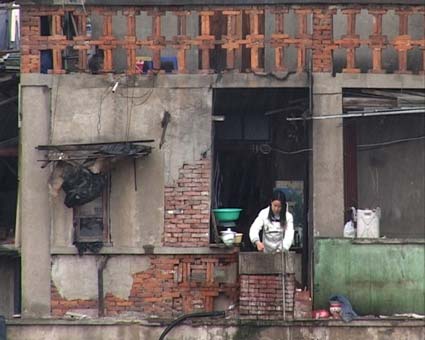  |
____________________________________________________________________________________________________
Cary Peppermint & Christine Nadir
|
 |
___________________________________________________________________________________________________
|
Framing the Frame with Distance NaoKo’s work highlights the ambiguities and confusions of national and individual identities often played out through language. Focusing on issues of dislocation, re-location and representation in a multi-cultural, multi-lingual society, she explores processes of continual translation: from thought to voice, between one language and another, through one media to the next. Framing the Frame with Distance is a live performance in both linear and non-linear environments. Naoko uses live linked webcast projection to examine the paradox of virtual and actual spaces.
|
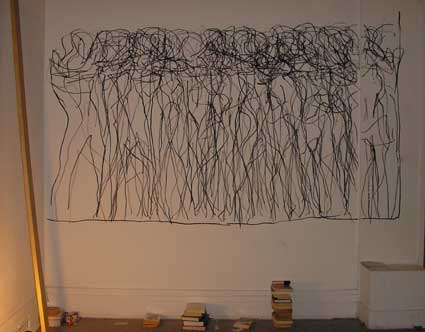 |
___________________________________________________________________________________________________
|
Transglobal Duets A movement duet each month in the same moment from different sides of the world. Over 30 minutes an improvisation develops in response to each environment as well as images/movements/presences that arise from awareness of each other being (t)here. Each month we choose a different location which will have similarities in atmosphere or form. Transglobal Duets is the continuation of movement explorations together that started in 2000 to do with communication, environment and place. |
 |
___________________________________________________________________________________________________
|
Beyond the Village of the Damned.
The systematic obsessive counting of the bricks and exploration of the barrier echoes a scene from the film "The Village of the Damned" (Wolf Rilla 1960)- based on the novel 'The Midwich Cuckoos' by John Wyndham, in which a group of alien children infiltrate an English village. In order to destroy this alien intrusion a local doctor becomes a suicide bomber. He successfully foils the alien attempts to read his mind by obsessing on the image of a brick wall. Projected five minute video loop with sound.
|
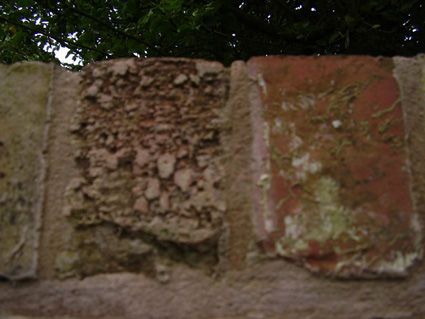 |
___________________________________________________________________________________________________
|
Inter(nal_in)vention is a new performance video
made especially for Dis-locate. While in Manchester, UK, the artist gave
directions to another artist in Tokyo using a map of Manchester. The
dialogue was made via mobile phone. The action took place at 12.15 UK
time and 20.15 Tokyo time. Exploring the outer landscape enables us to
find our inner landscape, and, in the same way as following the wrong
map, mobile technology can both confuse our sense of place and enrichen
our experience of it. Inter(nal_in)vention is about how a place can be
internalised in imaginary ways whether it has been seen, visualised,
visited or inhabited, and the subjectivity of interpretation. |
 |
___________________________________________________________________________________________________
|
Show me the way (to go
home)
Multiple voices telling
different and conflicting directions of how to go home. A multimedia
mesh of voiced directions, misconceptions and disconnections based on
consumer level GPS devices.
http://showmetheway.org.uk
|
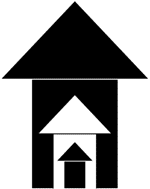 |
___________________________________________________________________________________________________
|
Re-presentations A city is both a geographical location as well as a collective identity that is often represented through architectural icons, tourist attractions, historic sites, public spaces, cultural institutions and popular locations. The images that get depicted through the news, in journals, in films, on websites, on postcards, and in the newspapers often become icons of a particular city, frequently illustrating a story, sometimes reaffirming a sense of place and overtime become part of the collective image of these locations. It is often through technologies that these locations are created and reaffirmed, while at the same time, these technologies allow one to experience locations while taking away a certain need to ever be at, inside or near the actual site. While in New Delhi, Maria started collecting images from local newspapers, searching specifically for architectural structures and the boundaries between locations, sites of interest or interaction. Choosing thread colours from the selected newspaper images, these representations were sewn onto paper, paying particular attention to the boundary where a site meets with another location or gets obstructed in the image. Through this process, gaps are formed in the selected site, giving the impression of an erasure or exclusion but also of a site currently being constructed. The newspaper image remains mostly hidden on the back of the drawing, leaving the viewer to see a reversed stitched outline of the way a particular site is represented and a sense of something lurking underneath with only the title (the picture caption from the article) as a direct guide.
|
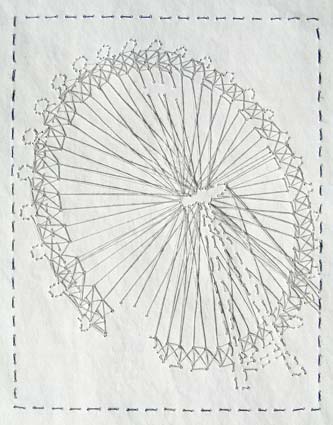 |
___________________________________________________________________________________________________
|
postcard… I collect and send postcards. I have always been interested in postcards as objects of documentation, in their ability to affect people and as a form of communication. Even in this age of instant electronic worldwide communication, people still ask to be sent postcards by those they know who travel. Why? I believe it makes people feel more connected to the person sending the card. We seem to value the time it takes to send a postcard more than an email. It is as if the sender has sent a part of themselves. It’s interesting...Postcards are objects we don’t delete. Between April 30th, 2007 and July 15th, 2007 I travelled around the world. During the course of the trip I collected digital images of actual postcards from the places I visited. For Dislocate 07 I have installed a simple stack of postcards on a table. The postcard has an image on one side made by a traditional stone stamp I had made while travelling; the other side of the postcard has an email address and instructions for the viewer. Individual viewers are invited to take a postcard, which will then allow them to interact with the artist and to experience a part of the artist travels around the world. The individual may select a date between April 30 and July 15 and email it to the email address on the card. After receiving the email the artist will send the individual a digital image of a postcard from the location the artist was on that day.
|
 |
___________________________________________________________________________________________________
8 to the power
(sound)
|
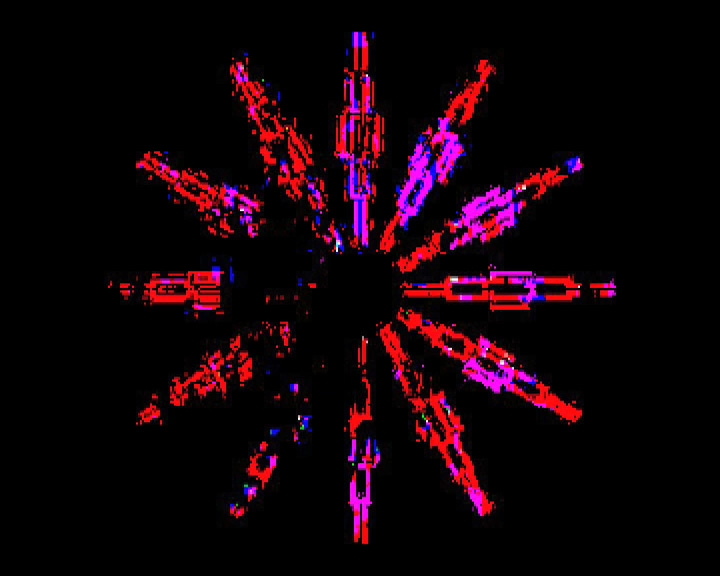 |